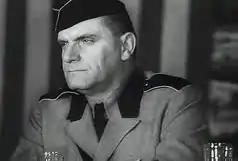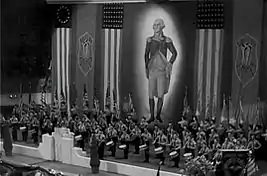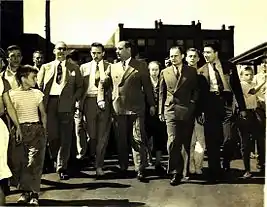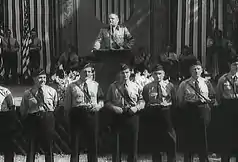Fritz Julius Kuhn
Fritz Julius Kuhn (May 15, 1896 – December 14, 1951) was a German Nazi activist who served as elected leader of the German American Bund before World War II. He became a naturalized United States citizen in 1934, but his citizenship was cancelled in 1943, and he was deported in 1945. He was an American supporter of the German Nazi government led by Adolf Hitler that ruled Germany from 1933 to 1945.[1]
Fritz Julius Kuhn | |
|---|---|
 Kuhn in 1938 | |
| Born | Fritz Julius Kuhn May 15, 1896 |
| Died | December 14, 1951 (aged 55) |
| Nationality | German |
| Citizenship | United States (1934-1943; revoked) |
| Occupation | Leader of the German American Bund |
| Spouse(s) | Elsa |
| Children | 2 |
| Parent(s) |
|



Early life
Kuhn was born in Munich, Germany, on May 15, 1896, the son of Georg Kuhn and Julia Justyna Beuth. During World War I, Kuhn earned an Iron Cross as a German infantry lieutenant.[2] After the war, he graduated from the Technical University of Munich with a master's degree in chemical engineering. In the 1920s, Kuhn moved to Mexico. In 1928, he moved to the United States and, in 1934, he became a naturalized citizen of the United States.[3] He worked at a Ford factory in Detroit before assuming control of the Bund in Buffalo, New York, in 1936.[4]
Leadership of the German-American bund
A Congressional committee headed by Samuel Dickstein concluded that the Friends of New Germany supported a branch of German dictator Adolf Hitler's Nazi Party in the United States,[5] and the Friends of New Germany disbanded. However, in March 1936, the German American Bund was established in Buffalo as a follow-up organization.[6] The Bund elected the German-born American citizen Kuhn as its leader.[7]
Kuhn, while describing the Bund as "sympathetic to the Hitler government", denied that the organization received money or took orders from the government of Germany. Kuhn also denied that the Bund had any agenda of introducing fascism to the United States.[8][9]
Kuhn enlisted thousands of Americans by using what would be criticized as antisemitic, anticommunist, and pro-German propaganda. One of his first tasks was to plan a trip to Germany with 50 of his American followers. The purpose was to be in the presence of Hitler and to personally witness National-Socialism in practice.
At this time, Germany was preparing to host the 1936 Olympics. Kuhn anticipated a warm welcome from Adolf Hitler, but the encounter was a disappointment. This did not stop Kuhn from elaborating more propaganda to his followers once he returned to the United States about how Hitler acknowledged him as the "American Führer".[10]
As his profile grew, so did the tension against him. Not only Jewish-Americans, but also German-Americans who did not want to be associated with Nazis, protested against the Bund. These protests were occasionally violent, making the Bund front page news in the United States. In response to the outrage of Jewish war veterans, Congress in 1938 passed the Foreign Agents Registration Act requiring foreign agents to register with the State Department.[10] The negative attention to the American Nazis was not to Hitler's liking because he wanted the Nazi Party in the United States to be strong, but stealthy. Hitler needed to keep the U.S. neutral throughout the coming war and sought to avoid provoking Americans, whereas Kuhn was eager to stir media attention. On March 1, 1938, the Nazi government decreed that no German national (Reichsdeutsche) could be a member of the Bund and that no Nazi emblems were to be used by the organization.[6]
Undaunted, on February 20, 1939, Kuhn held the largest and most publicized rally in the Bund's history at Madison Square Garden in New York City.[11] Some 20,000 people attended and heard Kuhn mock President Franklin D. Roosevelt as "Frank D. Rosenfeld", calling his New Deal the "Jew Deal" and denouncing what he called Bolshevik-Jewish American leadership. Kuhn also stated: "The Bund is fighting shoulder to shoulder with patriotic Americans to protect America from a race that is not the American race, that is not even a white race ... The Jews are enemies of the United States." Most shocking was the outbreak of violence between Bund storm troopers and thousands of angry protesters in the streets. During Kuhn's speech, a Jewish protester, Isadore Greenbaum, rushed the stage and had to be rescued by police after he was beaten and stripped by storm troopers.[12][13][14]
Criminal conviction
Later in 1939, seeking to cripple the Bund, New York City Mayor Fiorello La Guardia ordered the city to investigate the Bund's taxes. [15] It found that Kuhn had embezzled over $14,000 from the organization, spending part of the money on a mistress. [15] District Attorney Thomas E. Dewey issued an indictment and won a conviction against Kuhn. On December 5, 1939, Kuhn was sentenced to two and a half to five years in prison for tax evasion and embezzlement.[16] Despite his criminal conviction for embezzlement, followers of the Bund continued to hold Kuhn in high regard, in line with the Nazi Führerprinzip, which gives the leader absolute power.
Imprisonment and deportation
While in Sing Sing[4] prison, Kuhn's citizenship was revoked on June 1, 1943, on grounds of it having been obtained fraudulently as shown by his ongoing activity as a foreign agent of, and person with loyalty including oaths of military service towards, Germany and the Nazi Party.[3] Upon his release after spending 43 months in prison, Kuhn was re-arrested on June 21, 1943, as an enemy agent and interned by the federal government at a camp in Crystal City, Texas. After the war, Kuhn was sent to Ellis Island and deported to Germany on September 15, 1945.[3] Upon his arrival in Germany, he wanted to return to the United States,[17] but worked as a free man for more than two years as an industrial chemist in a small chemical factory in Munich. Then German authorities decided that he could be tried under Germany’s de-Nazification laws, and he was imprisoned in July 1947.[18]
Later life
Held in an internment camp at Dachau, awaiting trial before a Bavarian German denazification court, he escaped on February 4, 1948, but was recaptured on June 15 in the French zone town of Bernkastel, near Trier.[19] He faced a sentence of ten years at hard labor, having been found guilty in his absence after a five-hour trial on April 20. The proceeding was “made conspicuous by the absence of not only Kuhn but also of his lawyer and witnesses. The trial was carried out entirely by the presentation of documents which purported to show that Kuhn had close ties with Hitler’s Third German Reich and that he had tried to transplant its ideology into the United States.”[20] “How Kuhn escaped has never been officially explained, although there was an investigation, and the camp director, Anton Zirngibl, was fired. Kuhn told reporters, ‘The door was open so I went through.’”[21] Kuhn said on June 17 that he considered the ten-year sentence as a “major Nazi offender” unfair, and that he intended to appeal it.[22]
Kuhn was released shortly before his death.[23] While in prison, Kuhn reportedly sent a message to Jewish columnist Walter Winchell, who had helped lead media counterattacks against the Bund back in New York City. It read: "Tell Herr Vinchell, I will lift to piss on his grafe [sic]."[24] (Winchell died in 1972).
Death
Kuhn died on December 14, 1951, in Munich, Germany. The New York Times obituary said that he died "a poor and obscure chemist, unheralded and unsung".[1]
Appearance in media
In the alternative historical dystopian television series The Man in the High Castle, a high school on Long Island is named after Kuhn.
References
- "Fritz Kuhn Death in 1951 Revealed. Lawyer Says Former Leader of German-American Bund Succumbed in Munich". The New York Times. Associated Press. February 2, 1953. Retrieved 2008-07-20.
Fritz Kuhn, once the arrogant, noisy leader of the pro-Hitler German-American Bund, died here more than a year ago – a poor and obscure chemist, unheralded and unsung.
- Curt Riess (20 April 2017). Total Espionage: Germany's Information and Disinformation Apparatus 1932-40. Fonthill Media. GGKEY:W0990A01E5Q.
- "Fritz Kuhn, Former Bund Chief, Ordered Back to Germany". The Evening Independent. September 7, 1945.
- O'Haire, Hugh (May 8, 1977). "When the Bund Strutted in Yaphankl". The New York Times. Retrieved 28 May 2017.
- U.S. Congress, House Special Committee on Un-American Activities (1938). Investigation of un-American propaganda activities in the United States. United States Congress. p. 1090. Retrieved 11 October 2017.
- Jim Bredemus. "American Bund – The Failure of American Nazism: The German-American Bund's Attempt to Create an American 'Fifth Column'". TRACES. Archived from the original on 18 May 2011. Retrieved 2 March 2011.
- Cyprian Blamires; Paul Jackson (2006). World fascism: a historical encyclopedia, Volume 1. ABC-CLIO. p. 270. ISBN 0-8223-0772-3.
- Says Hitler Group is 200,000 strong. Kuhn Denies Trying to Set Up Fascism in U.S. Associated Press in Reading Eagle, March 12, 1937
- Kuhn Bares Bund Record Destruction. "Kuhn steadfastly denied that the German government had any connection with his organization." Associated Press in Reading Eagle, August 16, 1939
- Nazi America: A Secret History (2000), History Channel (92 min)
- Ratzis Fritz Kuhn and the Bund, 1939 by Jay Maeder Sunday, May 31st 1998
- "Fight Nazis in Big N.Y. Rally" (February 21, 1939). Chicago Tribune Archive. Chicago Tribune News Service. Retrieved 28 May 2017.
- Philpot, Robert (February 22, 2019). "Eighty years ago this week: the night the Nazis played Madison Square Garden". The Jewish Chronicle. London. Retrieved March 23, 2019.
- Philip Bump, When Nazis rallied in Manhattan, one working-class Jewish man from Brooklyn took them on, 20 February 2017, The Washington Post
- Duffy, Peter (2015). Double Agent: The First Hero of World War II and How the FBI Outwitted and Destroyed a Nazi Spy Ring. Scribner. p. 95. ISBN 978-1-45166-796-7. Retrieved November 23, 2019.
- Adams, Thomas (2005). Germany and the Americas: Culture, Politics, and History: A MultiDisciplinary Encyclopedia. G – N, volume 2. ABC-CLIO. p. 631. ISBN 1-85109-628-0. Retrieved January 11, 2011.
- Shaffer, Ryan (Spring 2010). "Long Island Nazis: A Local Synthesis of Transnational Politics". 21 (2). Journal of Long Island History. Archived from the original on 2010-06-21. Retrieved 2010-11-19.
- Associated Press, “Former Bund Leader Convicted In Absentia by German Court,” The San Bernardino Daily Sun, San Bernardino, California, Wednesday 21 April 1948, Volume LIV, Number 201, page 1.
- Associated Press, “Kuhn Captured In French Zone,” The San Bernardino Daily Sun, San Bernardino, California, Friday 18 June 1948, Volume LIV, Number 251, page 3.
- Associated Press, “Former Bund Leader Convicted In Absentia by German Court,” The San Bernardino Daily Sun, San Bernardino, California, Wednesday 21 April 1948, Volume LIV, Number 201, page 1.
- Associated Press, “Kuhn Captured In French Zone,” The San Bernardino Daily Sun, San Bernardino, California, Friday 18 June 1948, Volume LIV, Number 251, page 3.
- Associated Press, “Kuhn Captured In French Zone,” The San Bernardino Daily Sun, San Bernardino, California, Friday 18 June 1948, Volume LIV, Number 251, page 3.
- IMDb Biography
- Bernstein, Arnie (May 28, 2017). "Walter Winchell, Nazi Fighter". The New York Times Book Review: 6. Retrieved 27 May 2017.
External links
| Wikimedia Commons has media related to Fritz Julius Kuhn. |
- Talking History Archive - Recording of Fritz Kuhn's speech at the German-American Bund Rally, New York City, Feb. 20, 1939, at the University of Albany
- Fritz Julius Kuhn - Federal Bureau of Investigation (FBI)
- "American Bund: The Failure of American Nazism; The German-American Bund’s Attempt to Create an American 'Fifth Column'" Article by Jim Bredemus on Traces.org
- Fritz Julius Kuhn at IMDb
- Newspaper clippings about Fritz Julius Kuhn in the 20th Century Press Archives of the ZBW